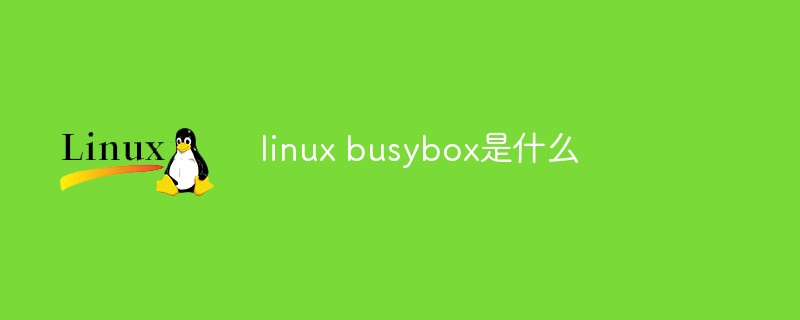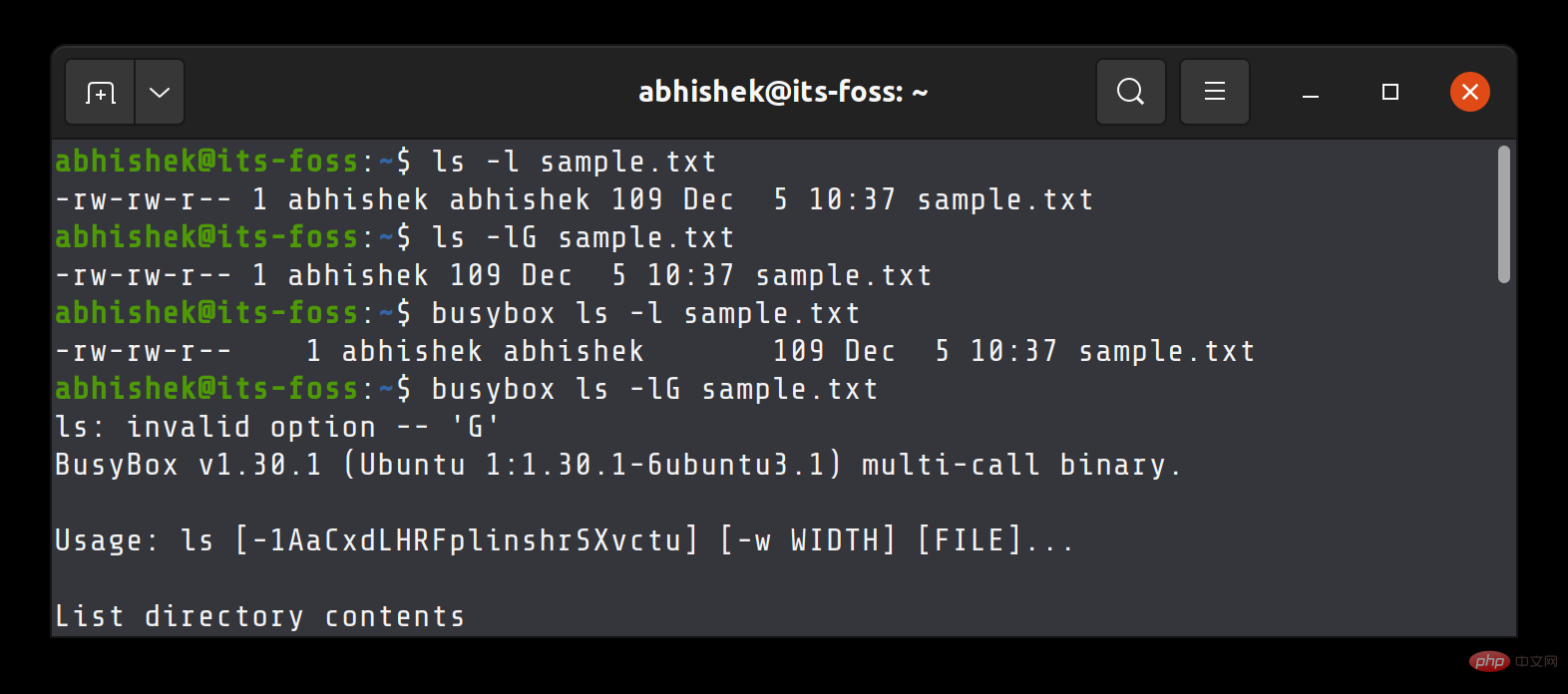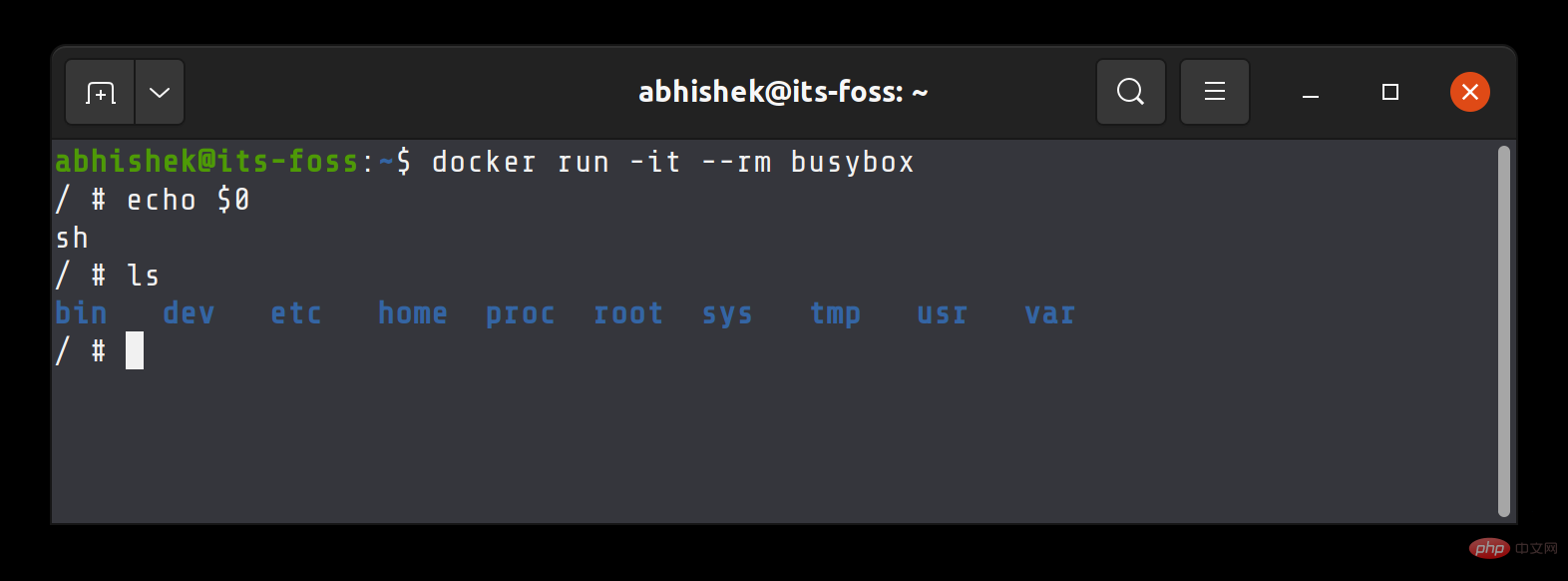what is linux busybox
busybox is a development tool for developing software under Linux systems. It is a software that integrates more than 300 of the most commonly used Linux commands and tools. To put it simply, BusyBox is like a big toolbox. It integrates and compresses many tools and commands of Linux, and also includes the Linux system’s own shell. BusyBox is an excellent alternative to GNU Coreutils, especially if the small size of the operating system is important.

#The operating environment of this tutorial: linux7.3 system, Dell G3 computer.
BusyBox is becoming more and more popular nowadays, especially among Docker users, and many Docker images use BusyBox to provide you with a minimal image.
This can be particularly confusing to many users if you take Linux commands for granted, thinking that ls, mv and other such commands are part of Linux, when in fact these commands are part of the GNU Coreutils package part of , and most Linux distributions come preinstalled.
GNU Coreutils is almost the de facto provider of various UNIX/Linux commands, almost because there are always alternatives, and BusyBox is one of the alternatives to GNU Coreutils.
What is BusyBox?
busybox is a development tool for developing software under Linux systems.
BusyBox is an open source project that provides streamlined implementations of approximately 400 common UNIX/Linux commands.
BusyBox is a software that integrates more than 300 of the most commonly used Linux commands and tools. BusyBox includes simple tools such as ls, cat, and echo, as well as larger and more complex tools such as grep, find, mount, and telnet. Some people call BusyBox the Swiss Army Knife of Linux tools. To put it simply, BusyBox is like a big toolbox. It integrates and compresses many tools and commands of Linux, and also includes the Linux system’s own shell.
BusyBox implementation removes uncommon, rarely used command options, everything is less than 1 MB, this minimal image is the reason why it is popular in the embedded systems and IoT world, as well as in the cloud computing world.
Don't look at its size, BusyBox has the scope of sed and awk like a classic editor (again in a stripped down version), it also contains its own shell, it even contains an init command that can be started as PID 1, This means BusyBox can be configured as a replacement for Systemd, OpenRC, etc.
BusyBox is an excellent alternative to GNU Coreutils, especially if the small size of the operating system is important.
BusyBox provides you with popular Linux commands like mv, mkdir, ls, etc., but it only includes common options for these commands. This minimalism is BusyBox’s USP.
Is it a problem that you don't get the full range of Linux command options with BusyBox?
It depends on your needs, really, most people will never need all the options of the command. Some Linux commands have over 50 options, and I bet you've never even used all the options for a single Linux command.
BusyBox reduces rarely used options, for example, the ls command has option G, which removes group names from long listing output (ls -l).

Now, I don't think you ever need this option, which is why it doesn't exist in BusyBox's ls implementation, if you do need one that doesn't contain the group name output, all you have to do is use the cut or awk command for this purpose.
Give another example. This is the help page for the mv command from GNU Coreutils:
Usage: mv [OPTION]... [-T] SOURCE DEST
or: mv [OPTION]... SOURCE... DIRECTORY
or: mv [OPTION]... -t DIRECTORY SOURCE...
Rename SOURCE to DEST, or move SOURCE(s) to DIRECTORY.
Mandatory arguments to long options are mandatory for short options too.
--backup[=CONTROL] make a backup of each existing destination file
-b like --backup but does not accept an argument
-f, --force do not prompt before overwriting
-i, --interactive prompt before overwrite
-n, --no-clobber do not overwrite an existing file
If you specify more than one of -i, -f, -n, only the final one takes effect.
--strip-trailing-slashes remove any trailing slashes from each SOURCE
argument
-S, --suffix=SUFFIX override the usual backup suffix
-t, --target-directory=DIRECTORY move all SOURCE arguments into DIRECTORY
-T, --no-target-directory treat DEST as a normal file
-u, --update move only when the SOURCE file is newer
than the destination file or when the
destination file is missing
-v, --verbose explain what is being done
-Z, --context set SELinux security context of destination
file to default type
--help display this help and exit
--version output version information and exitNow, here is the help page for the mv command from BusyBox:
Usage: mv [-fin] SOURCE DEST or: mv [-fin] SOURCE... DIRECTORY Rename SOURCE to DEST, or move SOURCE(s) to DIRECTORY -f Don't prompt before overwriting -i Interactive, prompt before overwrite -n Don't overwrite an existing file
See the difference?
How to get BusyBox?
You can get BusyBox in a variety of ways.
If you just want to experience BusyBox on your current Linux distribution, you can install it using your distribution's package manager (such as Apt or DNF or Yum).
On Ubuntu, you can install BusyBox using the following command:
sudo apt install busybox
After that, if you want to run the BusyBox version of the command, you must add busybox in front of it.
busybox cat sample.txt
If BusyBox does not implement the command, it will cause an error of "cannot find applet".
abhishek@LHB:~$ busybox xyz xyz: applet not found
Alternatively, you can download BusyBox’s Docker image and experience it in a running container.
Please make sure you have Docker installed, pull the official docker image:
docker pull busybox
Run a container from the image and enter the BusyBox shell:
docker run -it --rm busybox
Everything you run here Each Linux command comes from BusyBox. You don't need to specify it explicitly.

# In summary, you don’t need to use BusyBox on a regular Linux system, you already have the full version of Linux commands from GNU Coreutils. No need to install the lite version.
But BusyBox has its uses in special areas, such as when configuring a minimal Linux operating system for embedded or IoT devices. This is also true when you want to keep the size of your Docker image small.
Related recommendations: "Linux Video Tutorial"
The above is the detailed content of what is linux busybox. For more information, please follow other related articles on the PHP Chinese website!

Hot AI Tools

Undresser.AI Undress
AI-powered app for creating realistic nude photos

AI Clothes Remover
Online AI tool for removing clothes from photos.

Undress AI Tool
Undress images for free

Clothoff.io
AI clothes remover

AI Hentai Generator
Generate AI Hentai for free.

Hot Article

Hot Tools

Notepad++7.3.1
Easy-to-use and free code editor

SublimeText3 Chinese version
Chinese version, very easy to use

Zend Studio 13.0.1
Powerful PHP integrated development environment

Dreamweaver CS6
Visual web development tools

SublimeText3 Mac version
God-level code editing software (SublimeText3)

Hot Topics
 1384
1384
 52
52
 Difference between centos and ubuntu
Apr 14, 2025 pm 09:09 PM
Difference between centos and ubuntu
Apr 14, 2025 pm 09:09 PM
The key differences between CentOS and Ubuntu are: origin (CentOS originates from Red Hat, for enterprises; Ubuntu originates from Debian, for individuals), package management (CentOS uses yum, focusing on stability; Ubuntu uses apt, for high update frequency), support cycle (CentOS provides 10 years of support, Ubuntu provides 5 years of LTS support), community support (CentOS focuses on stability, Ubuntu provides a wide range of tutorials and documents), uses (CentOS is biased towards servers, Ubuntu is suitable for servers and desktops), other differences include installation simplicity (CentOS is thin)
 How to install centos
Apr 14, 2025 pm 09:03 PM
How to install centos
Apr 14, 2025 pm 09:03 PM
CentOS installation steps: Download the ISO image and burn bootable media; boot and select the installation source; select the language and keyboard layout; configure the network; partition the hard disk; set the system clock; create the root user; select the software package; start the installation; restart and boot from the hard disk after the installation is completed.
 Centos options after stopping maintenance
Apr 14, 2025 pm 08:51 PM
Centos options after stopping maintenance
Apr 14, 2025 pm 08:51 PM
CentOS has been discontinued, alternatives include: 1. Rocky Linux (best compatibility); 2. AlmaLinux (compatible with CentOS); 3. Ubuntu Server (configuration required); 4. Red Hat Enterprise Linux (commercial version, paid license); 5. Oracle Linux (compatible with CentOS and RHEL). When migrating, considerations are: compatibility, availability, support, cost, and community support.
 How to use docker desktop
Apr 15, 2025 am 11:45 AM
How to use docker desktop
Apr 15, 2025 am 11:45 AM
How to use Docker Desktop? Docker Desktop is a tool for running Docker containers on local machines. The steps to use include: 1. Install Docker Desktop; 2. Start Docker Desktop; 3. Create Docker image (using Dockerfile); 4. Build Docker image (using docker build); 5. Run Docker container (using docker run).
 Detailed explanation of docker principle
Apr 14, 2025 pm 11:57 PM
Detailed explanation of docker principle
Apr 14, 2025 pm 11:57 PM
Docker uses Linux kernel features to provide an efficient and isolated application running environment. Its working principle is as follows: 1. The mirror is used as a read-only template, which contains everything you need to run the application; 2. The Union File System (UnionFS) stacks multiple file systems, only storing the differences, saving space and speeding up; 3. The daemon manages the mirrors and containers, and the client uses them for interaction; 4. Namespaces and cgroups implement container isolation and resource limitations; 5. Multiple network modes support container interconnection. Only by understanding these core concepts can you better utilize Docker.
 What to do after centos stops maintenance
Apr 14, 2025 pm 08:48 PM
What to do after centos stops maintenance
Apr 14, 2025 pm 08:48 PM
After CentOS is stopped, users can take the following measures to deal with it: Select a compatible distribution: such as AlmaLinux, Rocky Linux, and CentOS Stream. Migrate to commercial distributions: such as Red Hat Enterprise Linux, Oracle Linux. Upgrade to CentOS 9 Stream: Rolling distribution, providing the latest technology. Select other Linux distributions: such as Ubuntu, Debian. Evaluate other options such as containers, virtual machines, or cloud platforms.
 How to view the docker process
Apr 15, 2025 am 11:48 AM
How to view the docker process
Apr 15, 2025 am 11:48 AM
Docker process viewing method: 1. Docker CLI command: docker ps; 2. Systemd CLI command: systemctl status docker; 3. Docker Compose CLI command: docker-compose ps; 4. Process Explorer (Windows); 5. /proc directory (Linux).
 What to do if the docker image fails
Apr 15, 2025 am 11:21 AM
What to do if the docker image fails
Apr 15, 2025 am 11:21 AM
Troubleshooting steps for failed Docker image build: Check Dockerfile syntax and dependency version. Check if the build context contains the required source code and dependencies. View the build log for error details. Use the --target option to build a hierarchical phase to identify failure points. Make sure to use the latest version of Docker engine. Build the image with --t [image-name]:debug mode to debug the problem. Check disk space and make sure it is sufficient. Disable SELinux to prevent interference with the build process. Ask community platforms for help, provide Dockerfiles and build log descriptions for more specific suggestions.




